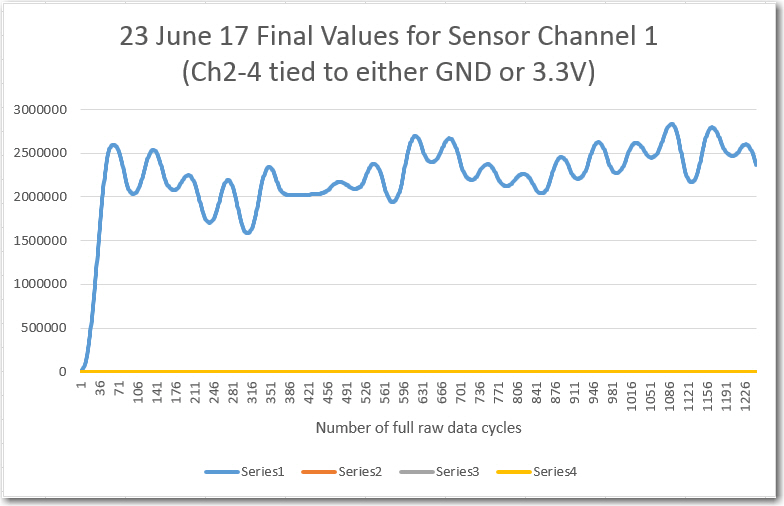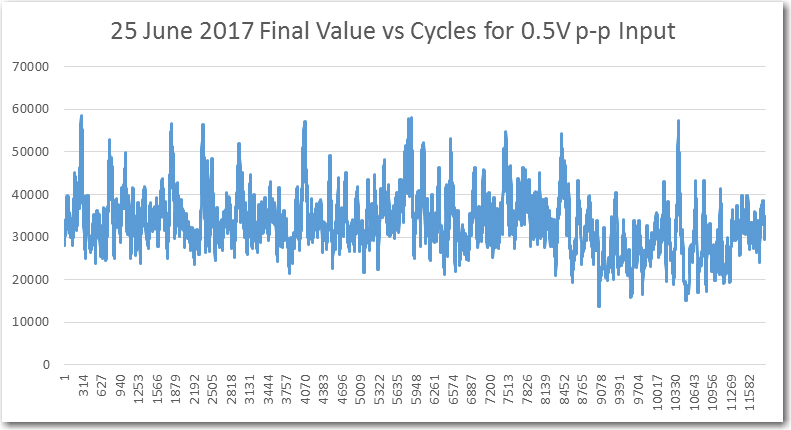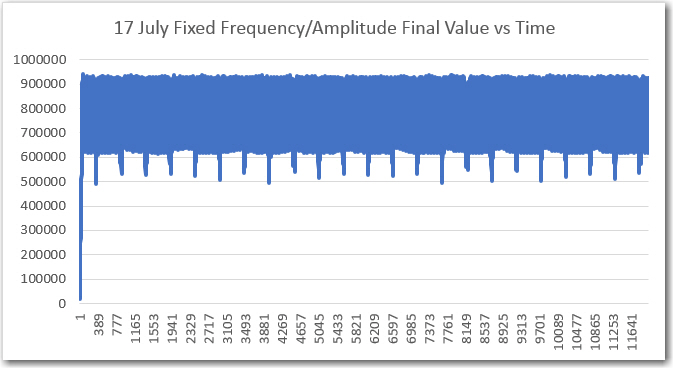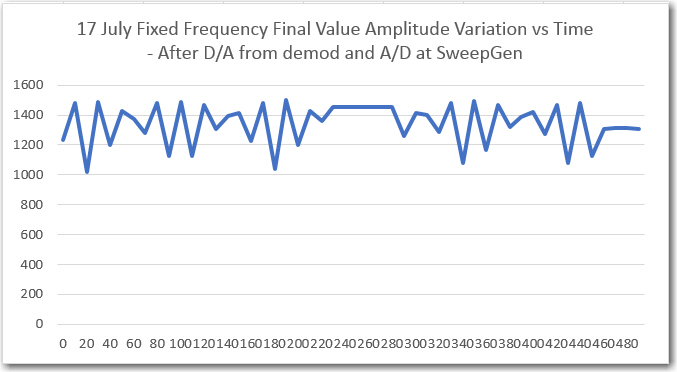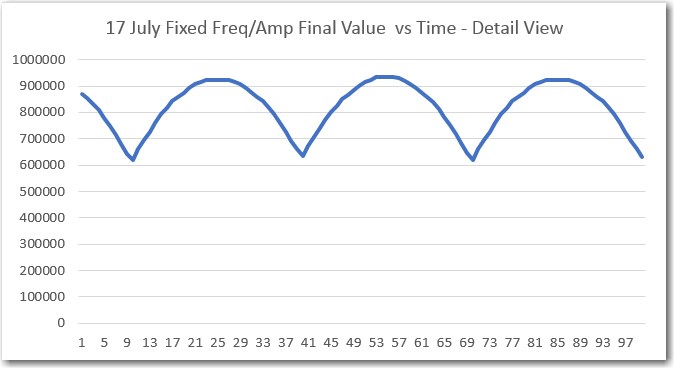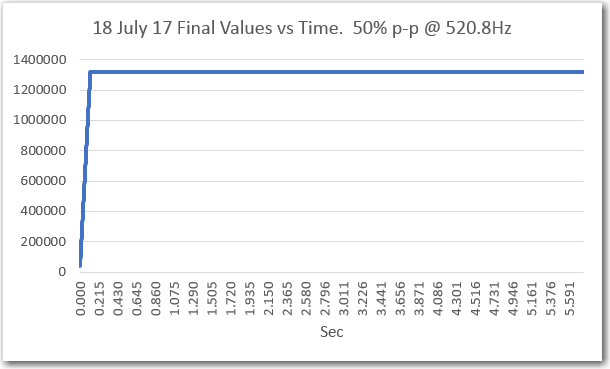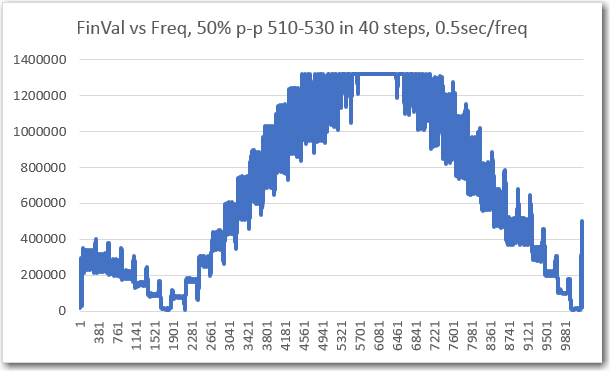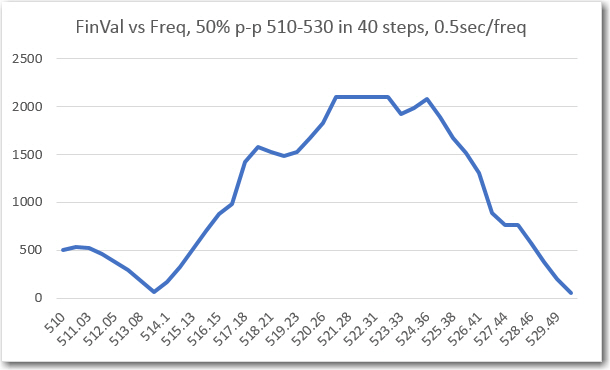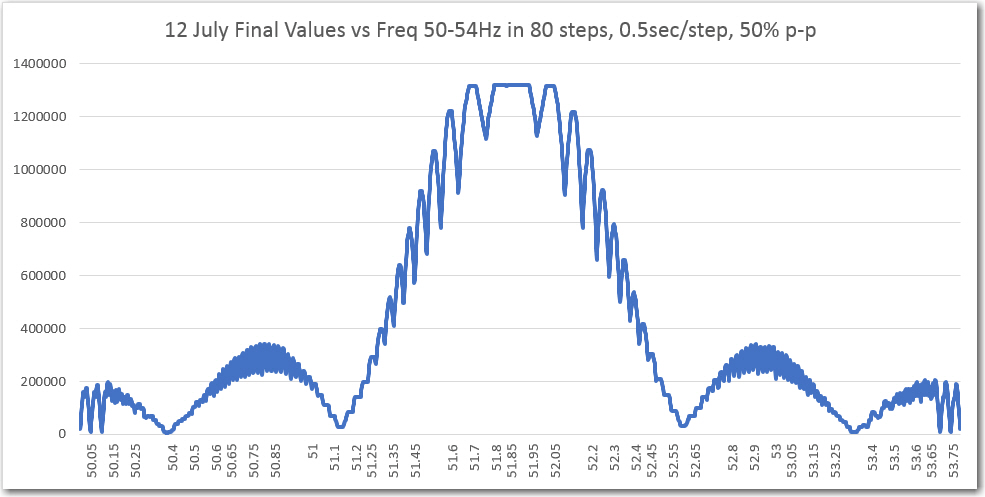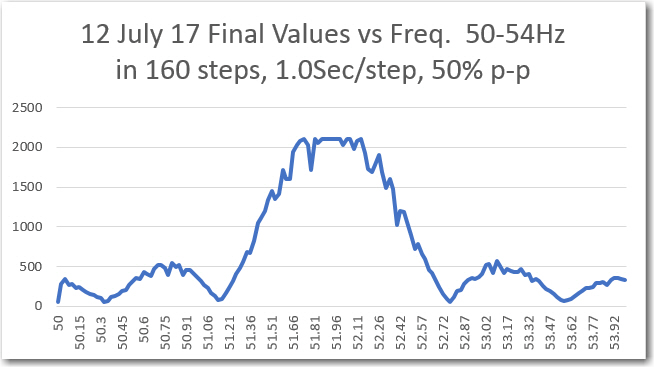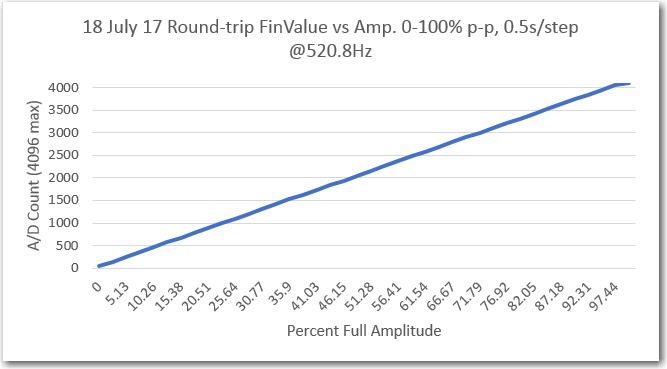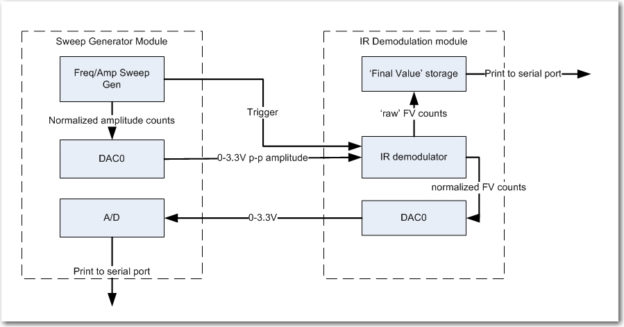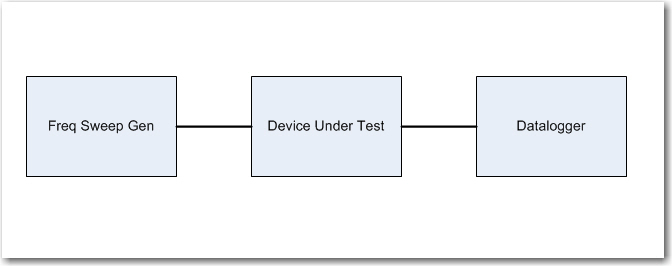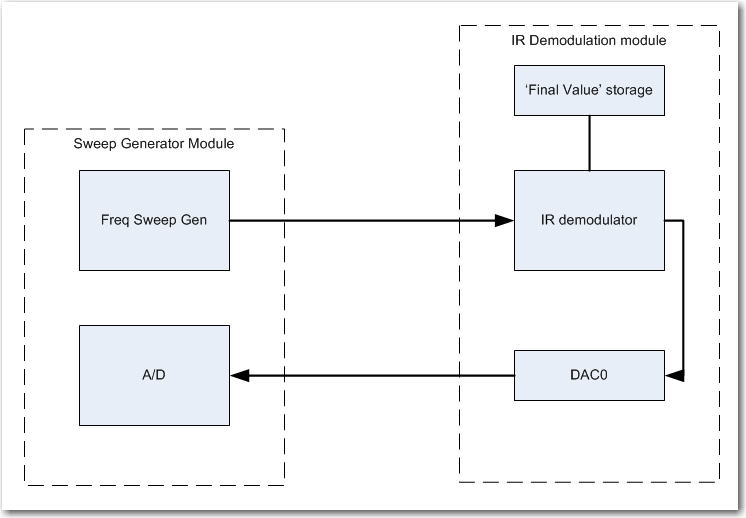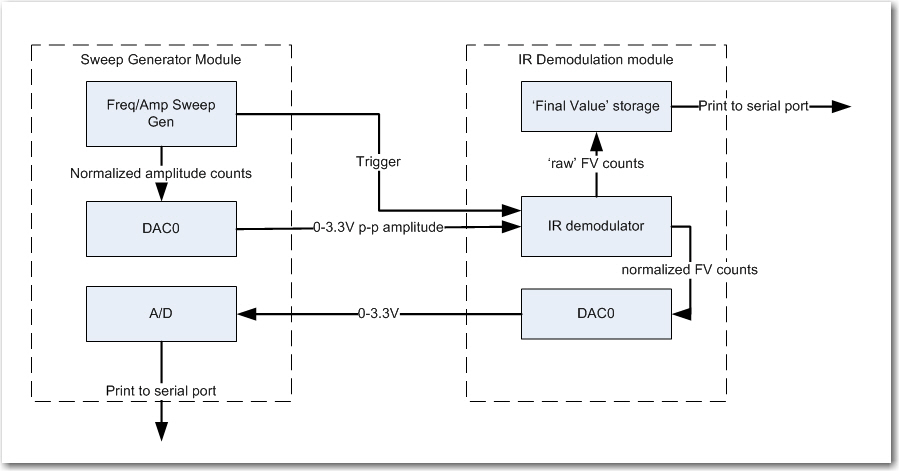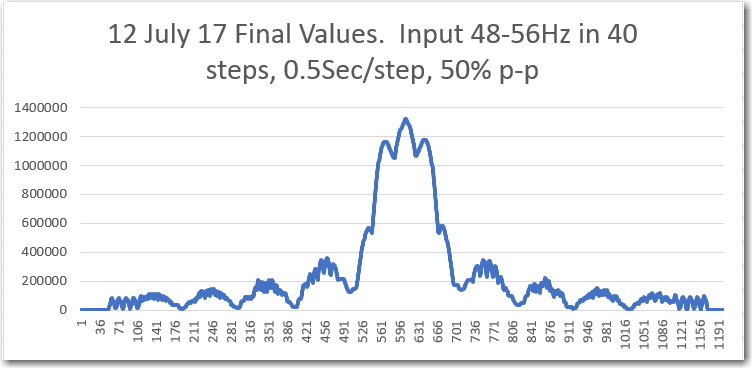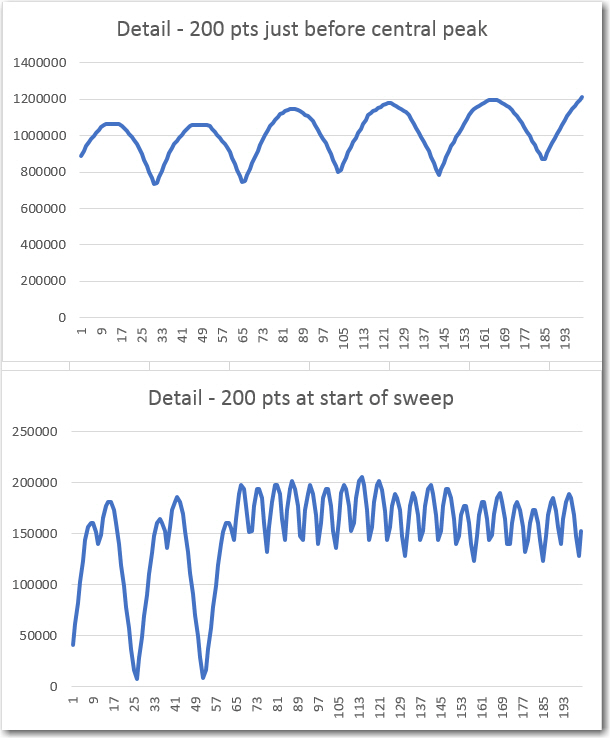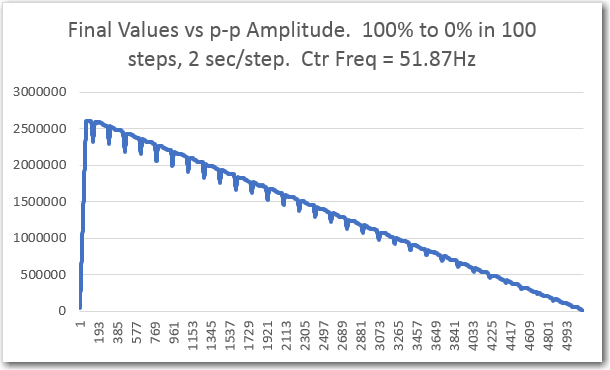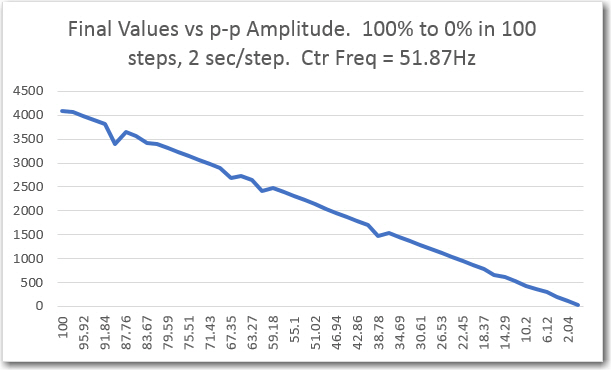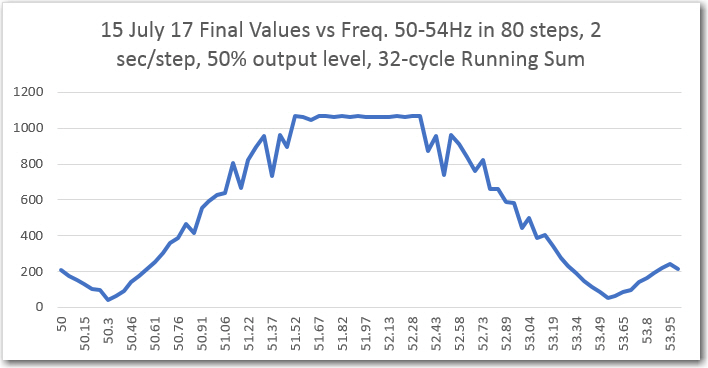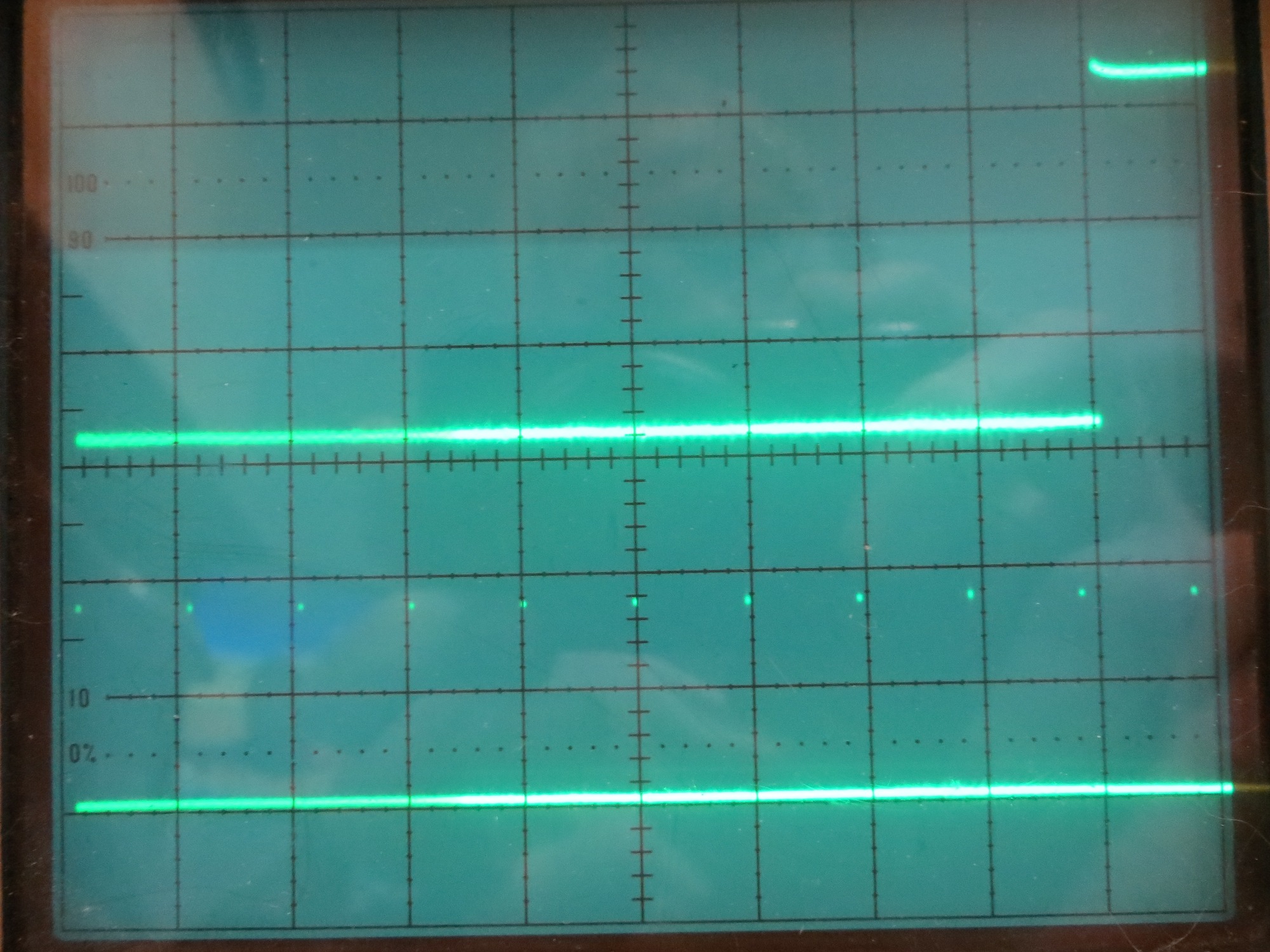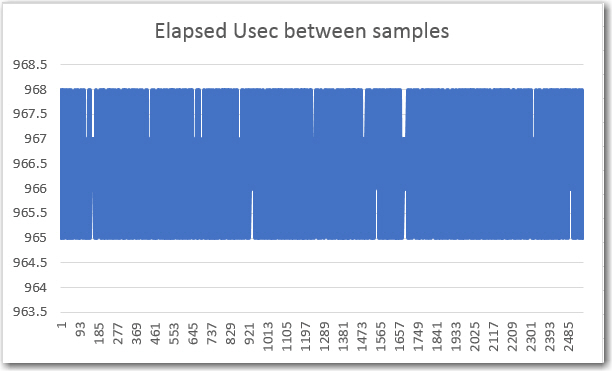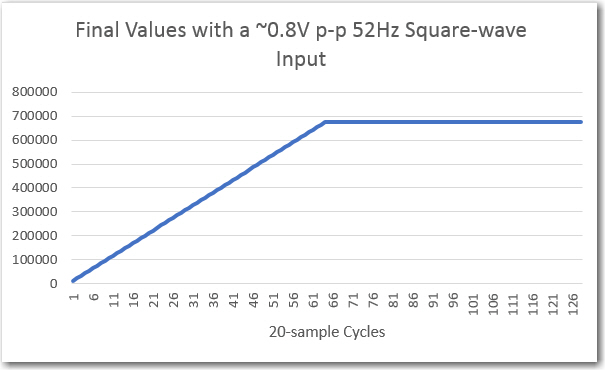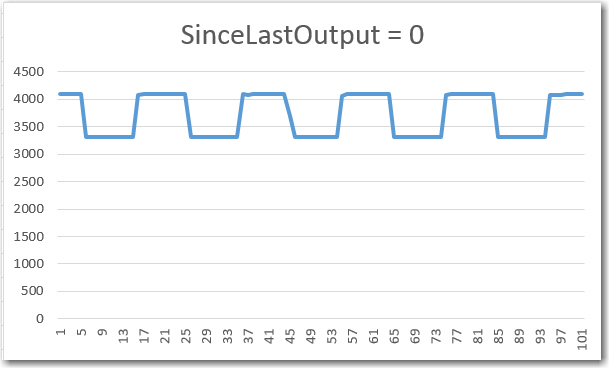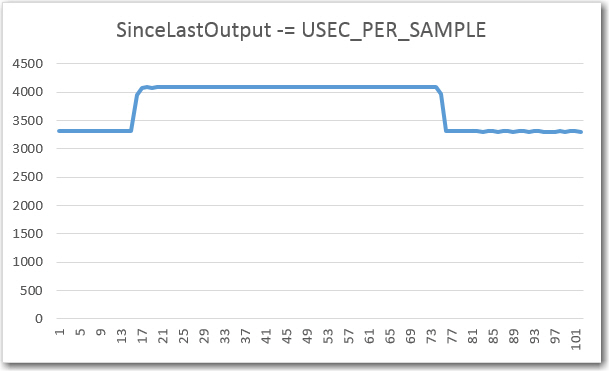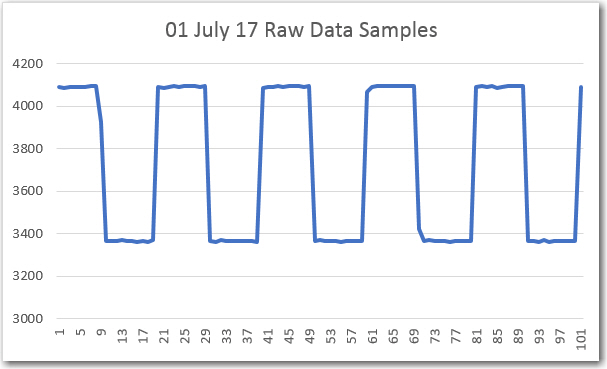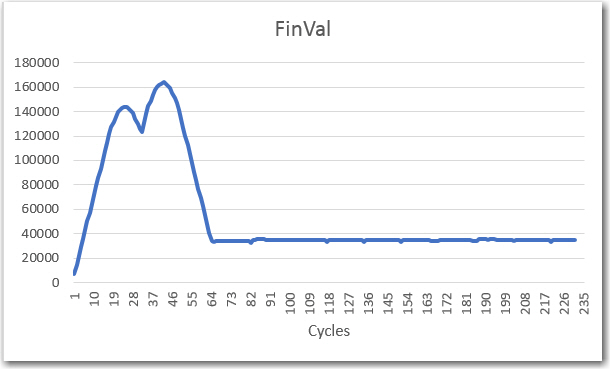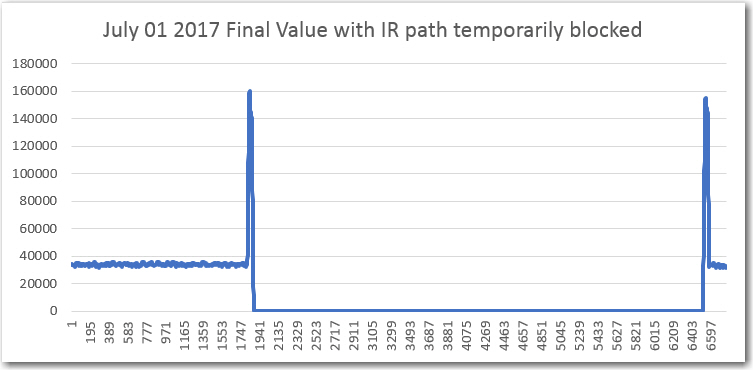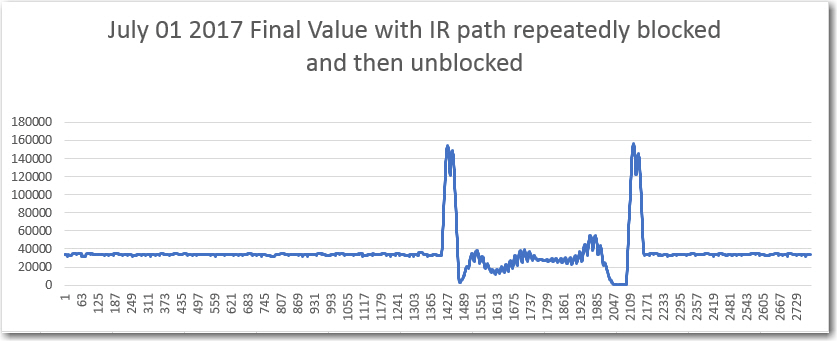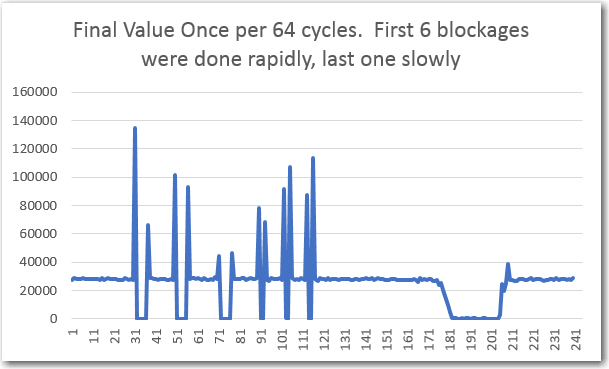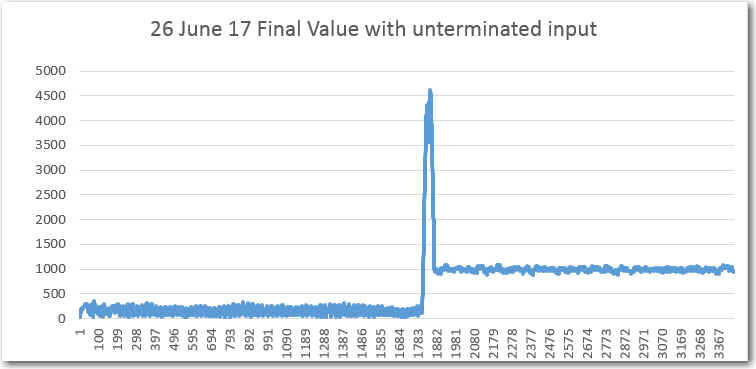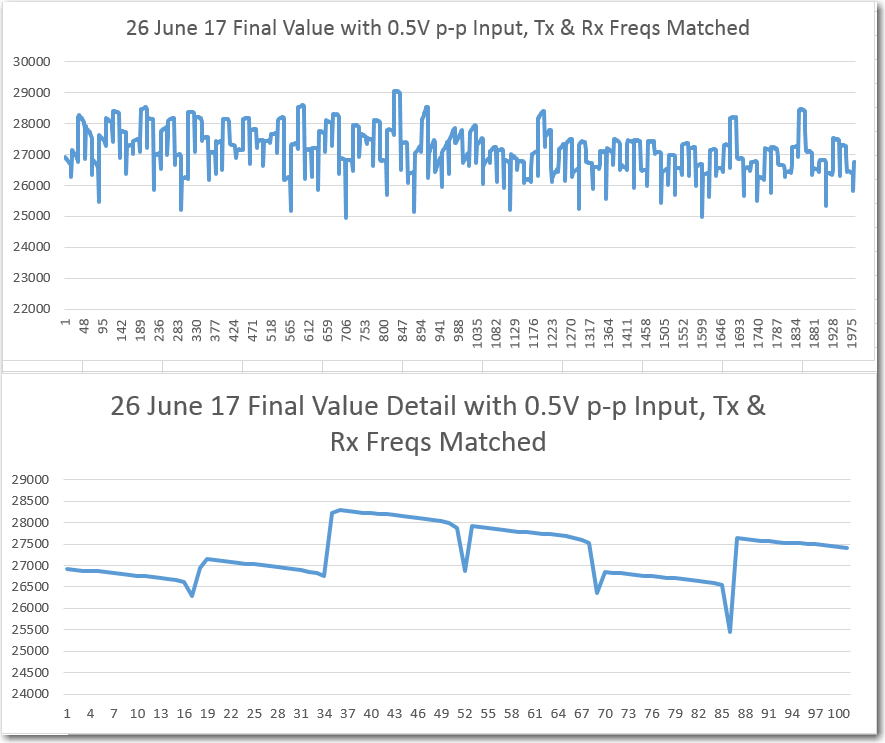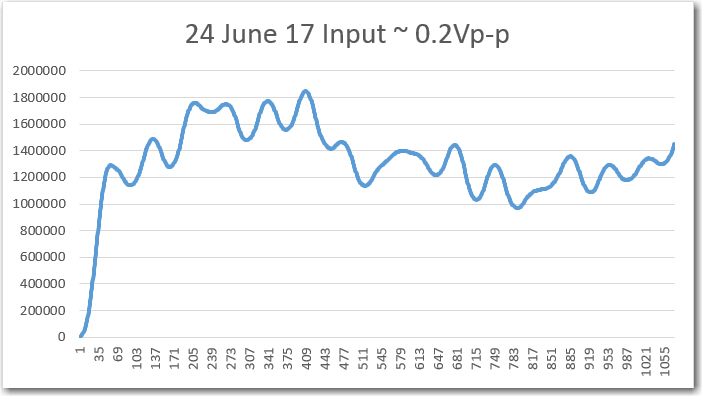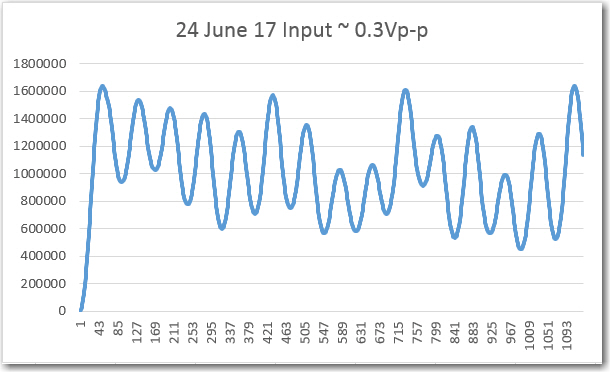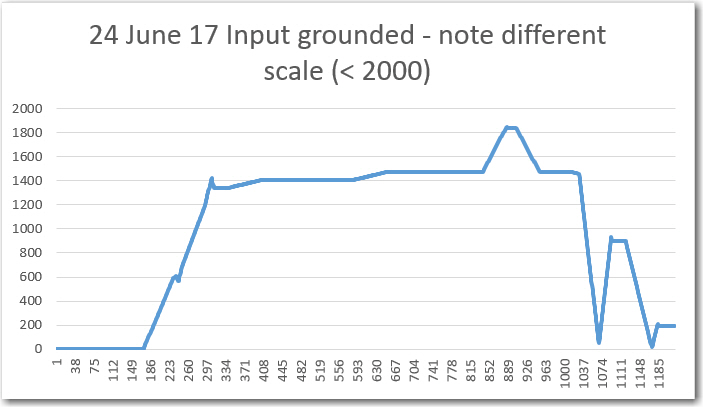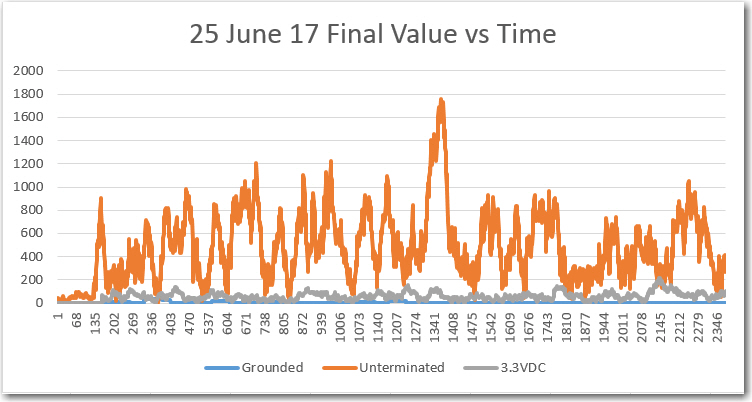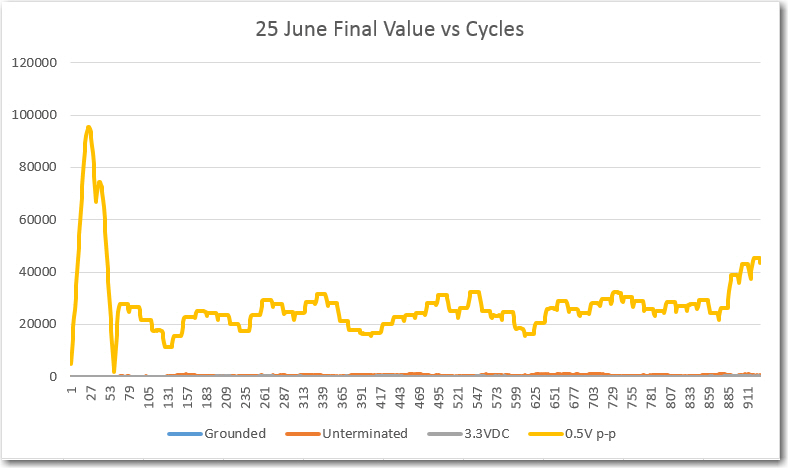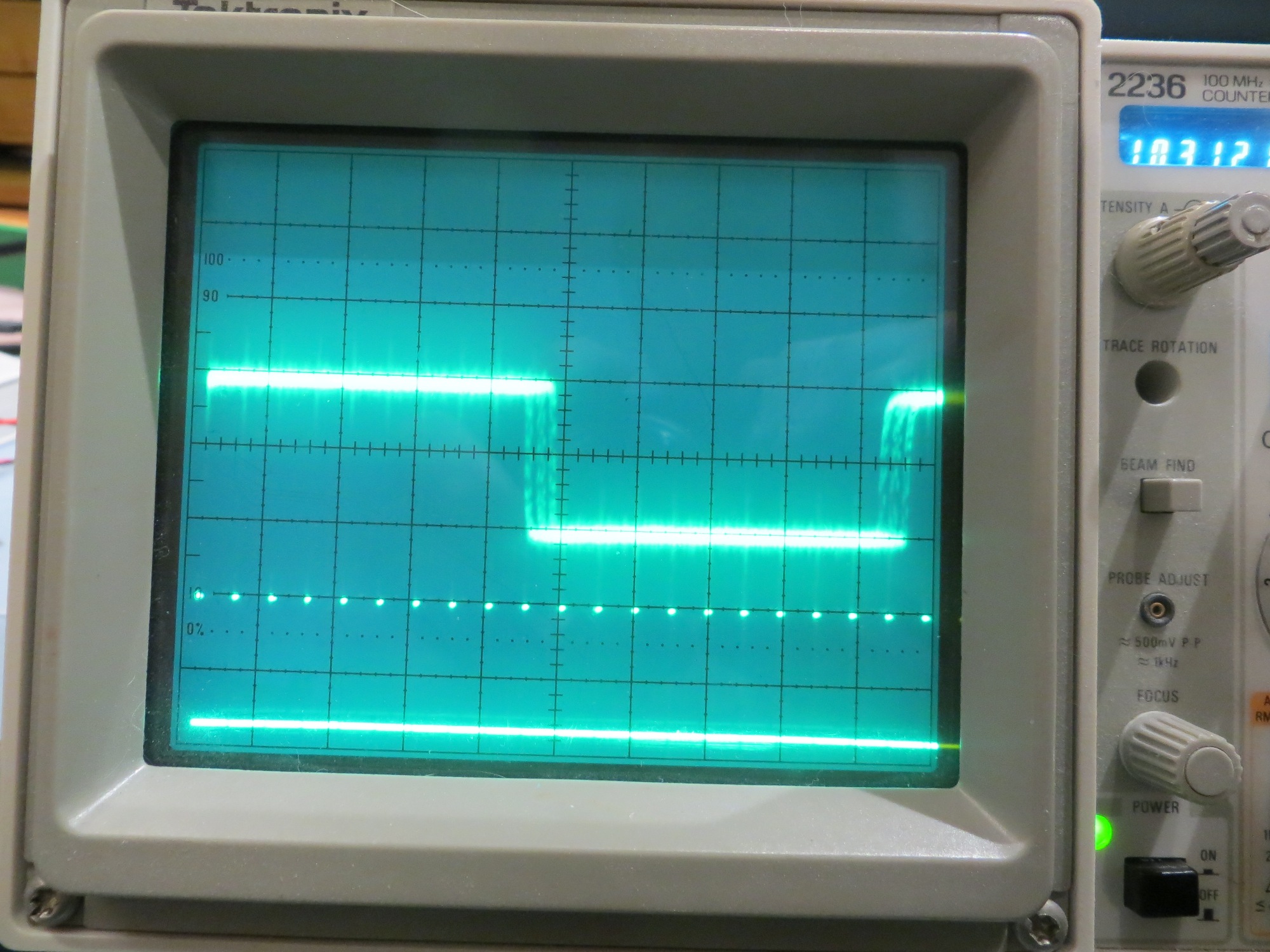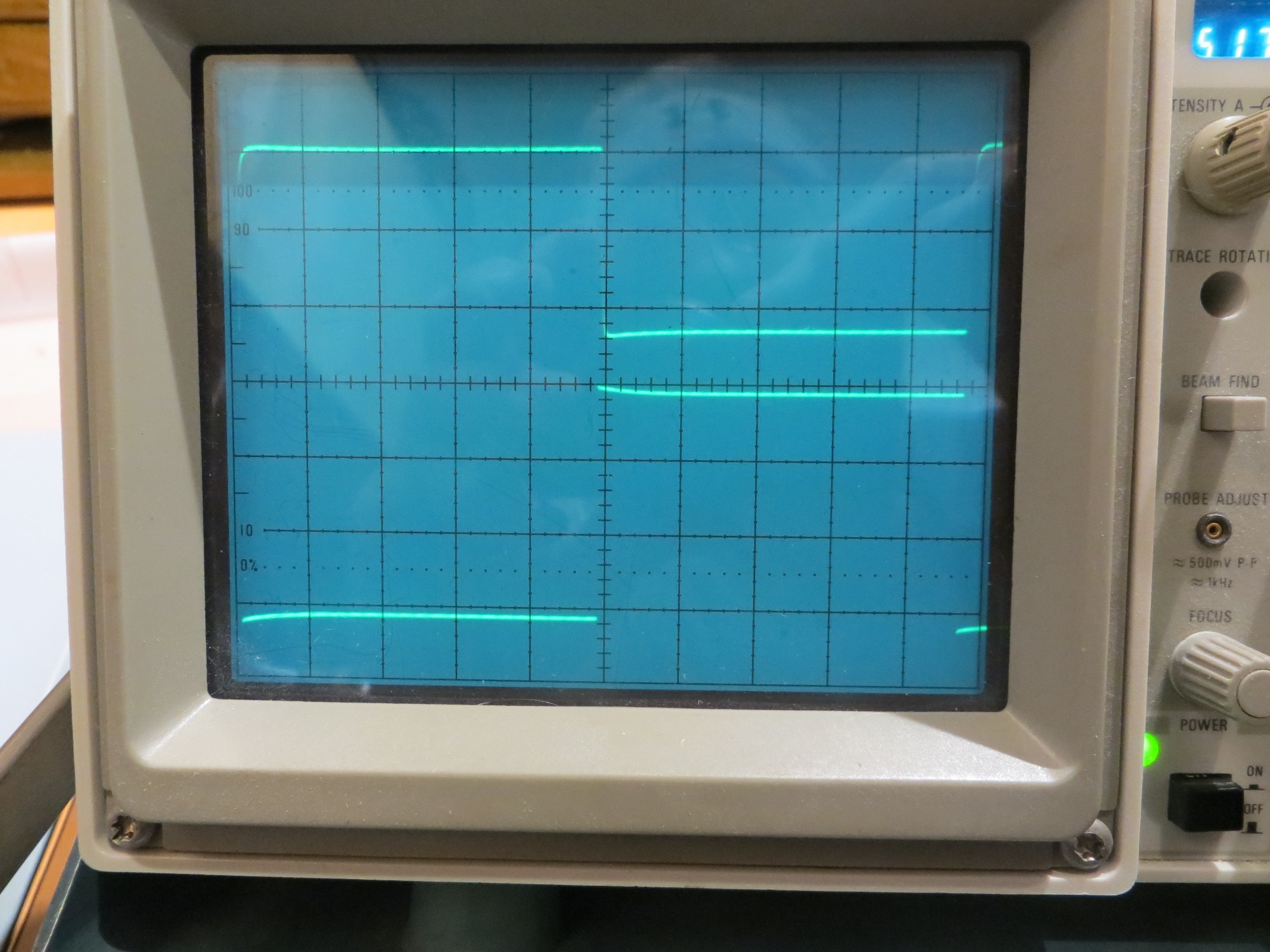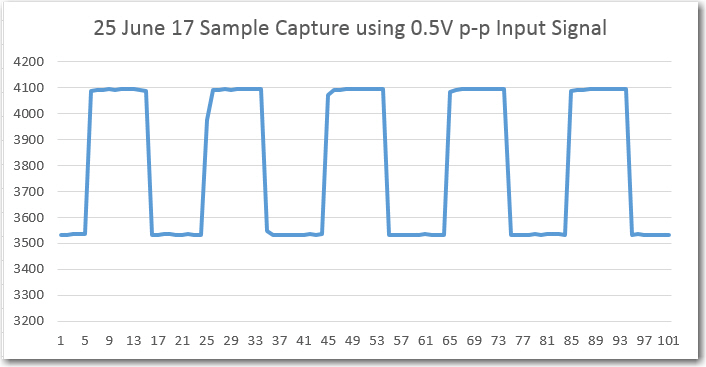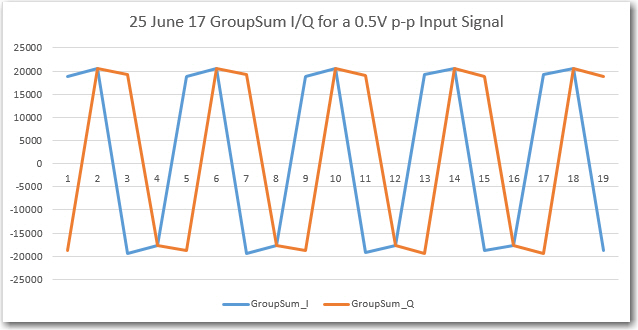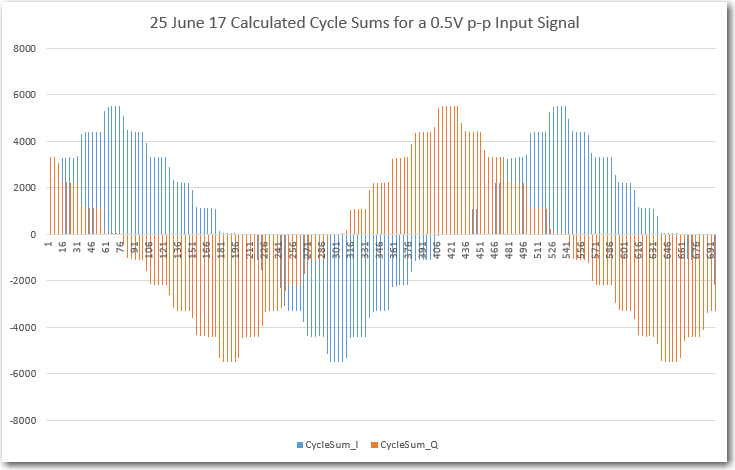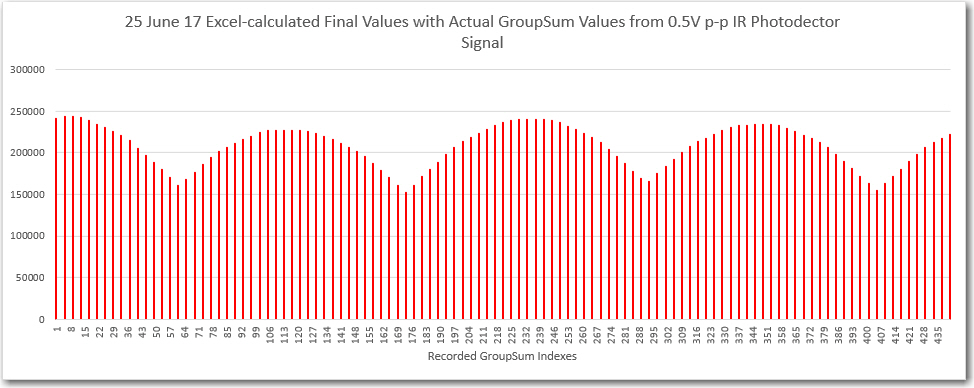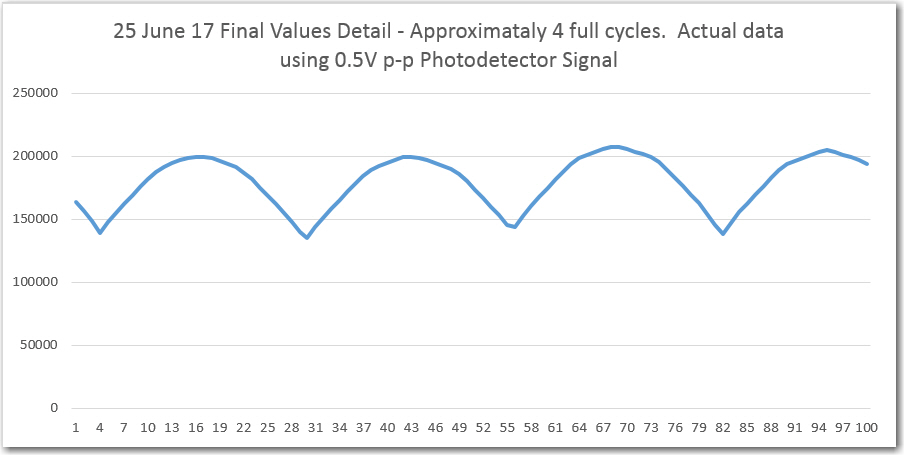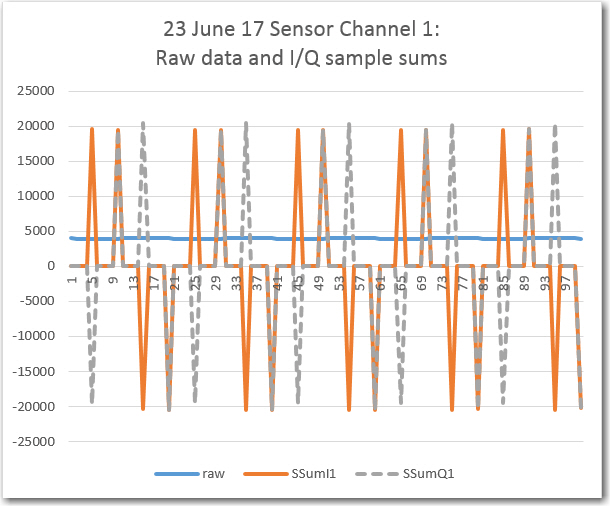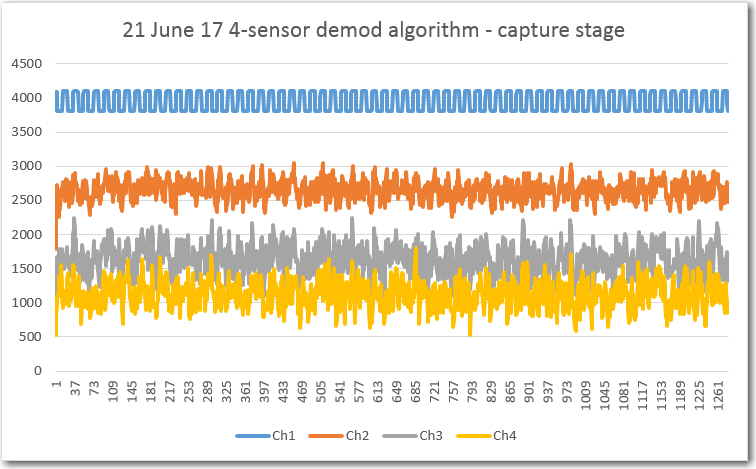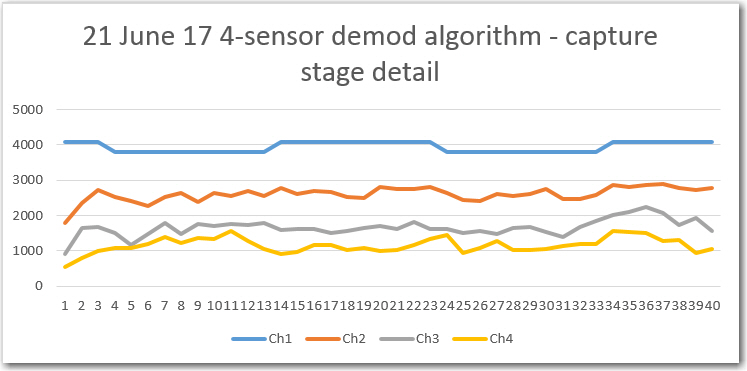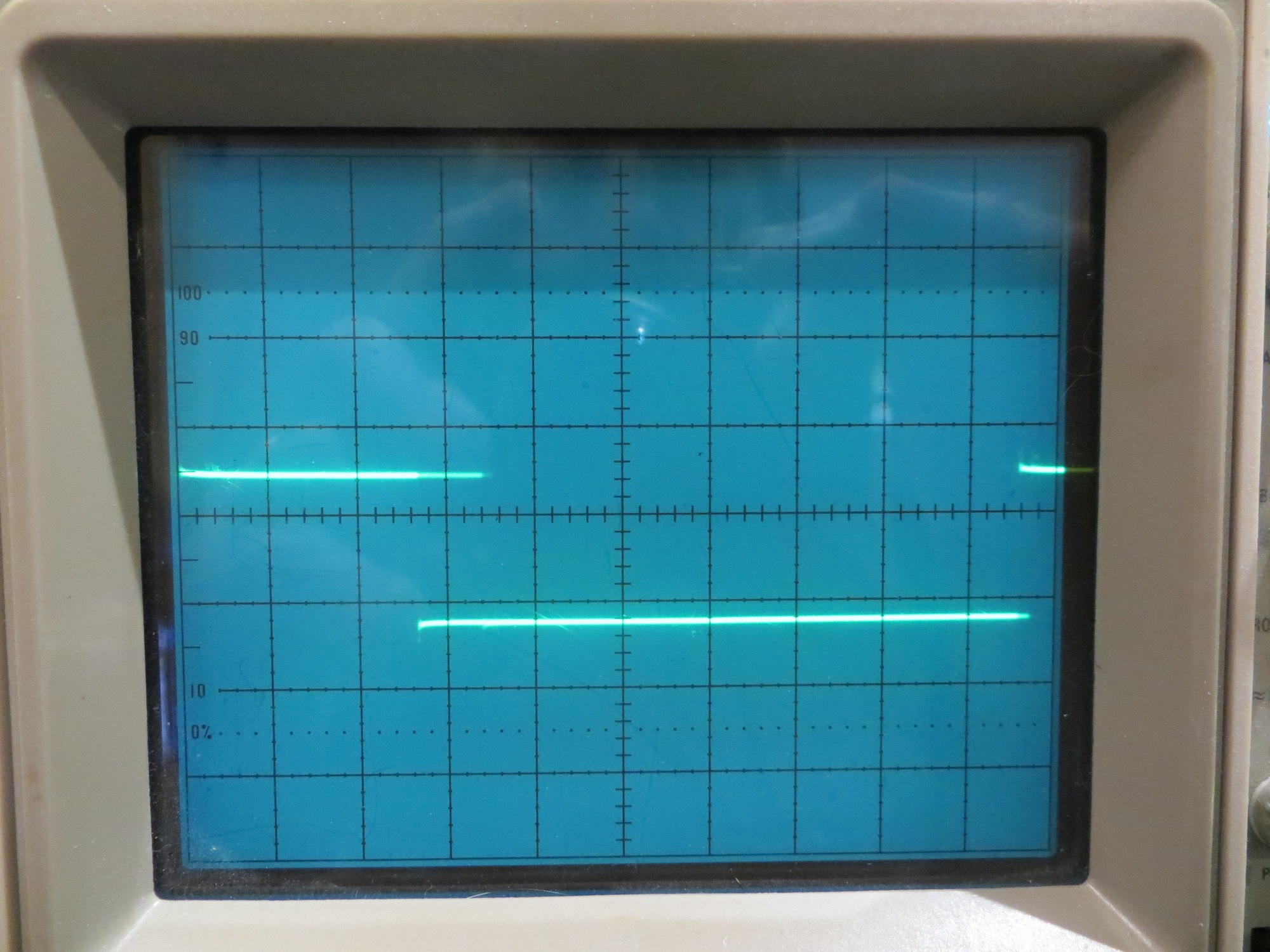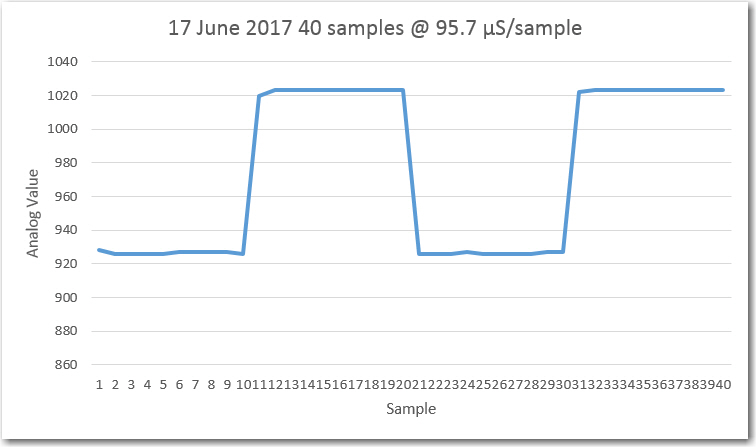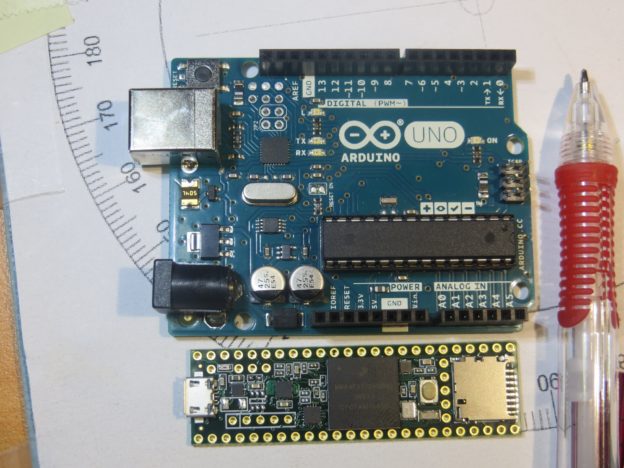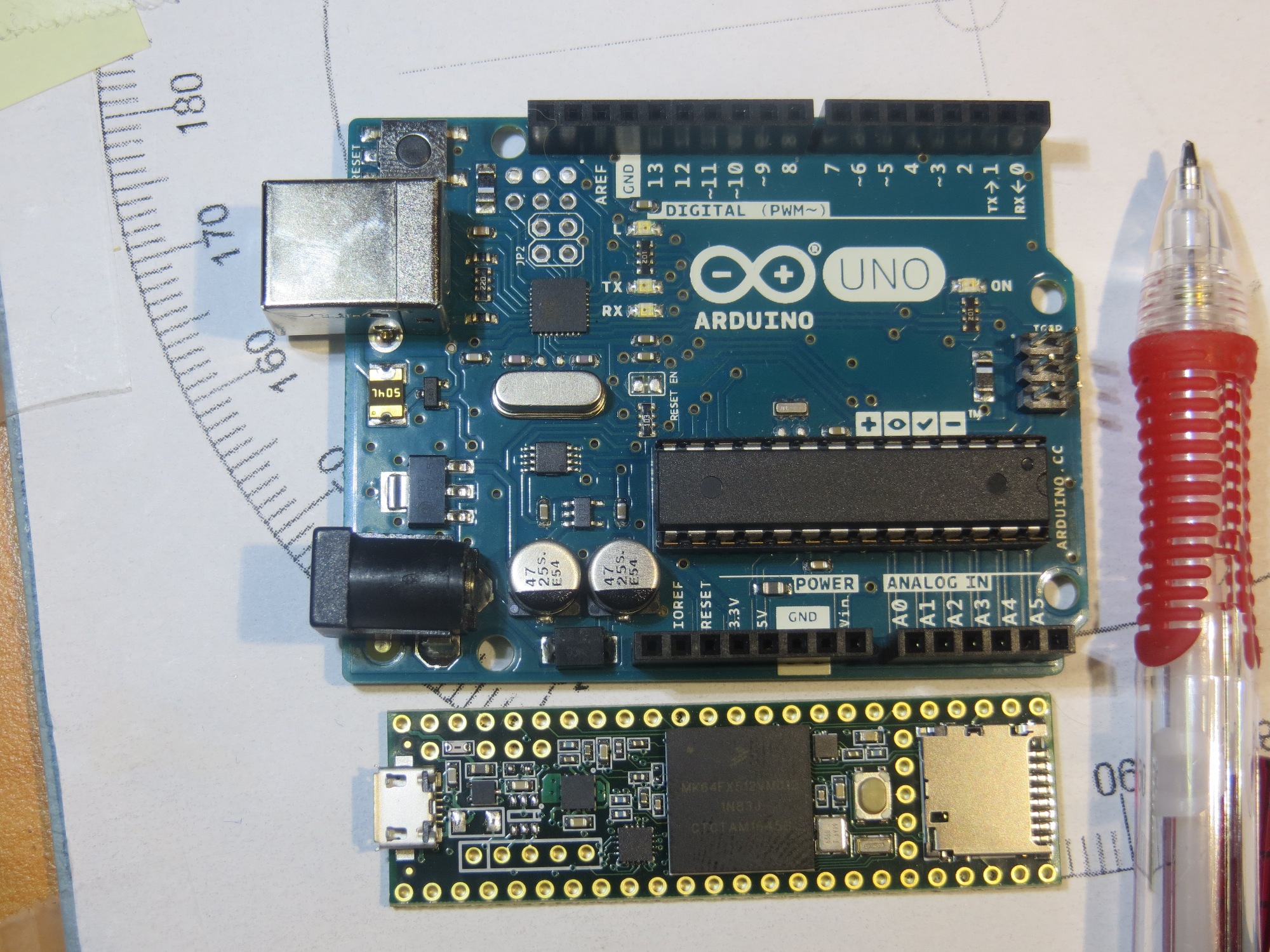RSI CSumI CSumQ OldRSI OldRSQ CurRSI CurRQ NewRSI NewRSQ FinVal
0 6523 657 0 0 0 0 6523 657 7180
1 5737 1453 0 0 6523 657 12260 2110 14370
2 5718 1444 0 0 12260 2110 17978 3554 21532
3 5647 1515 0 0 17978 3554 23625 5069 28694
4 4290 2860 0 0 23625 5069 27915 7929 35844
5 4281 2887 0 0 27915 7929 32196 10816 43012
6 4250 2906 0 0 32196 10816 36446 13722 50168
7 3472 3698 0 0 36446 13722 39918 17420 57338
8 2869 4311 0 0 39918 17420 42787 21731 64518
9 2838 4306 0 0 42787 21731 45625 26037 71662
10 2527 4617 0 0 45625 26037 48152 30654 78806
11 1410 5728 0 0 48152 30654 49562 36382 85944
12 1416 5750 0 0 49562 36382 50978 42132 93110
13 1389 5751 0 0 50978 42132 52367 47883 100250
14 450 6664 0 0 52367 47883 52817 54547 107364
15 -21 7155 0 0 52817 54547 52796 61702 114498
16 -14 7166 0 0 52796 61702 52782 68868 121650
17 -771 6403 0 0 52782 68868 52011 75271 127282
18 -1466 5718 0 0 52011 75271 50545 80989 131534
19 -1461 5717 0 0 50545 80989 49084 86706 135790
20 -1597 5577 0 0 49084 86706 47487 92283 139770
21 -2853 4315 0 0 47487 92283 44634 96598 141232
22 -2876 4292 0 0 44634 96598 41758 100890 142648
23 -2903 4283 0 0 41758 100890 38855 105173 144028
24 -3678 3476 0 0 38855 105173 35177 108649 143826
25 -4302 2838 0 0 35177 108649 30875 111487 142362
26 -4320 2842 0 0 30875 111487 26555 114329 140884
27 -4738 2424 0 0 26555 114329 21817 116753 138570
28 -5754 1424 0 0 21817 116753 16063 118177 134240
29 -5745 1415 0 0 16063 118177 10318 119592 129910
30 -5745 1373 0 0 10318 119592 4573 120965 125538
31 -6611 545 0 0 4573 120965 -2038 121510 123548
32 -7148 0 0 0 -2038 121510 -9186 121510 130696
33 -7143 -19 0 0 -9186 121510 -16329 121491 137820
34 -7100 -76 0 0 -16329 121491 -23429 121415 144844
35 -5724 -1456 0 0 -23429 121415 -29153 119959 149112
36 -5738 -1464 0 0 -29153 119959 -34891 118495 153386
37 -5714 -1468 0 0 -34891 118495 -40605 117027 157632
38 -4882 -2302 0 0 -40605 117027 -45487 114725 160212
39 -4284 -2876 0 0 -45487 114725 -49771 111849 161620
40 -4285 -2871 0 0 -49771 111849 -54056 108978 163034
41 -4096 -3064 0 0 -54056 108978 -58152 105914 164066
42 -2848 -4322 0 0 -58152 105914 -61000 101592 162592
43 -2846 -4316 0 0 -61000 101592 -63846 97276 161122
44 -2822 -4328 0 0 -63846 97276 -66668 92948 159616
45 -1575 -5587 0 0 -66668 92948 -68243 87361 155604
46 -1420 -5740 0 0 -68243 87361 -69663 81621 151284
47 -1402 -5736 0 0 -69663 81621 -71065 75885 146950
48 -673 -6455 0 0 -71065 75885 -71738 69430 141168
49 11 -7161 0 0 -71738 69430 -71727 62269 133996
50 20 -7158 0 0 -71727 62269 -71707 55111 126818
51 77 -7109 0 0 -71707 55111 -71630 48002 119632
52 1446 -5724 0 0 -71630 48002 -70184 42278 112462
53 1456 -5718 0 0 -70184 42278 -68728 36560 105288
54 1464 -5708 0 0 -68728 36560 -67264 30852 98116
55 2291 -4881 0 0 -67264 30852 -64973 25971 90944
56 2874 -4276 0 0 -64973 25971 -62099 21695 83794
57 2887 -4279 0 0 -62099 21695 -59212 17416 76628
58 3001 -4177 0 0 -59212 17416 -56211 13239 69450
59 4314 -2848 0 0 -56211 13239 -51897 10391 62288
60 4319 -2855 0 0 -51897 10391 -47578 7536 55114
61 4359 -2819 0 0 -47578 7536 -43219 4717 47936
62 5670 -1480 0 0 -43219 4717 -37549 3237 40786
63 5749 -1415 0 0 -37549 3237 -31800 1822 33622
0 5741 -1413 6523 657 -31800 1822 -32582 -248 32830 -32582 -248
1 6401 -737 5737 1453 -32582 -248 -31918 -2438 34356 -31918 -2438
2 7167 17 5718 1444 -31918 -2438 -30469 -3865 34334
3 7155 21 5647 1515 -30469 -3865 -28961 -5359 34320
4 7146 12 4290 2860 -28961 -5359 -26105 -8207 34312
5 6377 781 4281 2887 -26105 -8207 -24009 -10313 34322
6 5729 1439 4250 2906 -24009 -10313 -22530 -11780 34310
7 5722 1460 3472 3698 -22530 -11780 -20280 -14018 34298
8 5393 1763 2869 4311 -20280 -14018 -17756 -16566 34322
9 4288 2872 2838 4306 -17756 -16566 -16306 -18000 34306
10 4289 2865 2527 4617 -16306 -18000 -14544 -19752 34296
11 4264 2898 1410 5728 -14544 -19752 -11690 -22582 34272
12 3152 4006 1416 5750 -11690 -22582 -9954 -24326 34280
13 2843 4315 1389 5751 -9954 -24326 -8500 -25762 34262
14 2842 4318 450 6664 -8500 -25762 -6108 -28108 34216
15 2092 5086 -21 7155 -6108 -28108 -3995 -30177 34172
16 1410 5754 -14 7166 -3995 -30177 -2571 -31589 34160
17 1414 5742 -771 6403 -2571 -31589 -386 -32250 32636
18 1340 5828 -1466 5718 -386 -32250 2420 -32140 34560
19 302 6824 -1461 5717 2420 -32140 4183 -31033 35216
20 5 7127 -1597 5577 4183 -31033 5785 -29483 35268
21 -30 7152 -2853 4315 5785 -29483 8608 -26646 35254
22 -832 6346 -2876 4292 8608 -26646 10652 -24592 35244
23 -1462 5718 -2903 4283 10652 -24592 12093 -23157 35250
24 -1455 5725 -3678 3476 12093 -23157 14316 -20908 35224
25 -1678 5532 -4302 2838 14316 -20908 16940 -18214 35154
26 -2884 4300 -4320 2842 16940 -18214 18376 -16756 35132
27 -2888 4280 -4738 2424 18376 -16756 20226 -14900 35126
28 -2874 4270 -5754 1424 20226 -14900 23106 -12054 35160
29 -3818 3342 -5745 1415 23106 -12054 25033 -10127 35160
30 -4309 2859 -5745 1373 25033 -10127 26469 -8641 35110
31 -4330 2842 -6611 545 26469 -8641 28750 -6344 35094
32 -4987 2167 -7148 0 28750 -6344 30911 -4177 35088
33 -5751 1419 -7143 -19 30911 -4177 32303 -2739 35042
34 -5749 1415 -7100 -76 32303 -2739 33654 -1248 34902
35 -5836 1310 -5724 -1456 33654 -1248 33542 1518 35060
36 -7155 -5 -5738 -1464 33542 1518 32125 2977 35102
37 -7144 2 -5714 -1468 32125 2977 30695 4447 35142
38 -7143 -23 -4882 -2302 30695 4447 28434 6726 35160
39 -7058 -108 -4284 -2876 28434 6726 25660 9494 35154
40 -5731 -1449 -4285 -2871 25660 9494 24214 10916 35130
41 -5720 -1448 -4096 -3064 24214 10916 22590 12532 35122
42 -5688 -1478 -2848 -4322 22590 12532 19750 15376 35126
43 -4482 -2690 -2846 -4316 19750 15376 18114 17002 35116
44 -4301 -2891 -2822 -4328 18114 17002 16635 18439 35074
45 -4271 -2891 -1575 -5587 16635 18439 13939 21135 35074
46 -3900 -3270 -1420 -5740 13939 21135 11459 23605 35064
47 -2858 -4322 -1402 -5736 11459 23605 10003 25019 35022
48 -2834 -4300 -673 -6455 10003 25019 7842 27174 35016
49 -2812 -4342 11 -7161 7842 27174 5019 29993 35012
50 -1457 -5689 20 -7158 5019 29993 3542 31462 35004
51 -1402 -5746 77 -7109 3542 31462 2063 32825 34888
52 -1400 -5760 1446 -5724 2063 32825 -783 32789 33572
53 -670 -6466 1456 -5718 -783 32789 -2909 32041 34950
54 20 -7162 1464 -5708 -2909 32041 -4353 30587 34940
55 34 -7142 2291 -4881 -4353 30587 -6610 28326 34936
56 92 -7092 2874 -4276 -6610 28326 -9392 25510 34902
57 1441 -5717 2887 -4279 -9392 25510 -10838 24072 34910
58 1455 -5713 3001 -4177 -10838 24072 -12384 22536 34920
59 1475 -5703 4314 -2848 -12384 22536 -15223 19681 34904
60 2494 -4690 4319 -2855 -15223 19681 -17048 17846 34894
61 2889 -4287 4359 -2819 -17048 17846 -18518 16378 34896
62 2883 -4281 5670 -1480 -18518 16378 -21305 13577 34882
63 3491 -3681 5749 -1415 -21305 13577 -23563 11311 34874
0 4306 -2846 5741 -1413 -23563 11311 -24998 9878 34876
1 4320 -2838 6401 -737 -24998 9878 -27079 7777 34856
2 4339 -2809 7167 17 -27079 7777 -29907 4951 34858
3 5733 -1437 7155 21 -29907 4951 -31329 3493 34822
4 5738 -1414 7146 12 -31329 3493 -32737 2067 34804
5 5762 -1398 6377 781 -32737 2067 -33352 -112 33464
6 6609 -561 5729 1439 -33352 -112 -32472 -2112 34584
7 7145 1 5722 1460 -32472 -2112 -31049 -3571 34620
8 7149 -1 5393 1763 -31049 -3571 -29293 -5335 34628
9 7128 42 4288 2872 -29293 -5335 -26453 -8165 34618
10 6252 918 4289 2865 -26453 -8165 -24490 -10112 34602
11 5736 1452 4264 2898 -24490 -10112 -23018 -11558 34576
12 5707 1453 3152 4006 -23018 -11558 -20463 -14111 34574
13 5099 2079 2843 4315 -20463 -14111 -18207 -16347 34554
14 4306 2882 2842 4318 -18207 -16347 -16743 -17783 34526
15 4280 2862 2092 5086 -16743 -17783 -14555 -20007 34562
16 4212 2932 1410 5754 -14555 -20007 -11753 -22829 34582
17 2889 4261 1414 5742 -11753 -22829 -10278 -24310 34588
18 2857 4323 1340 5828 -10278 -24310 -8761 -25815 34576
19 2834 4318 302 6824 -8761 -25815 -6229 -28321 34550
20 2074 5088 5 7127 -6229 -28321 -4160 -30360 34520
21 1421 5735 -30 7152 -4160 -30360 -2709 -31777 34486
22 1416 5728 -832 6346 -2709 -31777 -461 -32395 32856
23 1235 5895 -1462 5718 -461 -32395 2236 -32218 34454
24 -19 7151 -1455 5725 2236 -32218 3672 -30792 34464
25 -19 7153 -1678 5532 3672 -30792 5331 -29171 34502
26 -29 7139 -2884 4300 5331 -29171 8186 -26332 34518
27 -893 6297 -2888 4280 8186 -26332 10181 -24315 34496
28 -1467 5723 -2874 4270 10181 -24315 11588 -22862 34450
29 -1459 5723 -3818 3342 11588 -22862 13947 -20481 34428
30 -1962 5192 -4309 2859 13947 -20481 16294 -18148 34442
31 -2877 4273 -4330 2842 16294 -18148 17747 -16717 34464
32 -2885 4269 -4987 2167 17747 -16717 19849 -14615 34464
33 -2943 4219 -5751 1419 19849 -14615 22657 -11815 34472
34 -4228 2954 -5749 1415 22657 -11815 24178 -10276 34454
35 -4321 2859 -5836 1310 24178 -10276 25693 -8727 34420
36 -4346 2860 -7155 -5 25693 -8727 28502 -5862 34364
37 -5080 2096 -7144 2 28502 -5862 30566 -3768 34334
38 -5735 1413 -7143 -23 30566 -3768 31974 -2332 34306
39 -5747 1423 -7058 -108 31974 -2332 33285 -801 34086
40 -6155 1007 -5731 -1449 33285 -801 32861 1655 34516
41 -7177 -17 -5720 -1448 32861 1655 31404 3086 34490
42 -7144 -12 -5688 -1478 31404 3086 29948 4552 34500
43 -7155 -3 -4482 -2690 29948 4552 27275 7239 34514
44 -6818 -348 -4301 -2891 27275 7239 24758 9782 34540
45 -5729 -1445 -4271 -2891 24758 9782 23300 11228 34528
46 -5714 -1454 -3900 -3270 23300 11228 21486 13044 34530
47 -5667 -1503 -2858 -4322 21486 13044 18677 15863 34540
48 -4279 -2881 -2834 -4300 18677 15863 17232 17282 34514
49 -4289 -2887 -2812 -4342 17232 17282 15755 18737 34492
50 -4279 -2891 -1457 -5689 15755 18737 12933 21535 34468
51 -3507 -3639 -1402 -5746 12933 21535 10828 23642 34470
52 -2843 -4305 -1400 -5760 10828 23642 9385 25097 34482
53 -2832 -4334 -670 -6466 9385 25097 7223 27229 34452
54 -2774 -4384 20 -7162 7223 27229 4429 30007 34436
55 -1420 -5726 34 -7142 4429 30007 2975 31423 34398
56 -1424 -5736 92 -7092 2975 31423 1459 32779 34238
57 -1403 -5759 1441 -5717 1459 32779 -1385 32737 34122
58 -554 -6596 1455 -5713 -1385 32737 -3394 31854 35248
59 18 -7160 1475 -5703 -3394 31854 -4851 30397 35248
60 18 -7154 2494 -4690 -4851 30397 -7327 27933 35260
61 234 -6950 2889 -4287 -7327 27933 -9982 25270 35252
62 1449 -5737 2883 -4281 -9982 25270 -11416 23814 35230
63 1444 -5692 3491 -3681 -11416 23814 -13463 21803 35266
0 1484 -5686 4306 -2846 -13463 21803 -16285 18963 35248
1 2874 -4296 4320 -2838 -16285 18963 -17731 17505 35236
2 2896 -4286 4339 -2809 -17731 17505 -19174 16028 35202
3 2888 -4282 5733 -1437 -19174 16028 -22019 13183 35202
4 3695 -3481 5738 -1414 -22019 13183 -24062 11116 35178
5 4298 -2850 5762 -1398 -24062 11116 -25526 9664 35190
6 4310 -2846 6609 -561 -25526 9664 -27825 7379 35204
7 4415 -2729 7145 1 -27825 7379 -30555 4649 35204
8 5742 -1408 7149 -1 -30555 4649 -31962 3242 35204
9 5749 -1421 7128 42 -31962 3242 -33341 1779 35120
10 5772 -1404 6252 918 -33341 1779 -33821 -543 34364
11 6994 -176 5736 1452 -33821 -543 -32563 -2171 34734
12 7146 8 5707 1453 -32563 -2171 -31124 -3616 34740
13 7154 10 5099 2079 -31124 -3616 -29069 -5685 34754
14 7132 52 4306 2882 -29069 -5685 -26243 -8515 34758
15 5983 1191 4280 2862 -26243 -8515 -24540 -10186 34726
16 5730 1440 4212 2932 -24540 -10186 -23022 -11678 34700
17 5717 1451 2889 4261 -23022 -11678 -20194 -14488 34682
18 4965 2211 2857 4323 -20194 -14488 -18086 -16600 34686
19 4300 2890 2834 4318 -18086 -16600 -16620 -18028 34648
20 4278 2880 2074 5088 -16620 -18028 -14416 -20236 34652
21 4142 3016 1421 5735 -14416 -20236 -11695 -22955 34650
22 2858 4308 1416 5728 -11695 -22955 -10253 -24375 34628
23 2853 4289 1235 5895 -10253 -24375 -8635 -25981 34616
24 2820 4336 -19 7151 -8635 -25981 -5796 -28796 34592
25 2049 5121 -19 7153 -5796 -28796 -3728 -30828 34556
26 1410 5738 -29 7139 -3728 -30828 -2289 -32229 34518
27 1420 5732 -893 6297 -2289 -32229 24 -32794 32818
28 1020 6138 -1467 5723 24 -32794 2511 -32379 34890
29 -23 7173 -1459 5723 2511 -32379 3947 -30929 34876
30 -28 7138 -1962 5192 3947 -30929 5881 -28983 34864
31 -38 7124 -2877 4273 5881 -28983 8720 -26132 34852
32 -1075 6107 -2885 4269 8720 -26132 10530 -24294 34824
33 -1443 5721 -2943 4219 10530 -24294 12030 -22792 34822
34 -1457 5715 -4228 2954 12030 -22792 14801 -20031 34832
35 -2203 4975 -4321 2859 14801 -20031 16919 -17915 34834
36 -2889 4279 -4346 2860 16919 -17915 18376 -16496 34872
37 -2881 4281 -5080 2096 18376 -16496 20575 -14311 34886
38 -2956 4176 -5735 1413 20575 -14311 23354 -11548 34902
